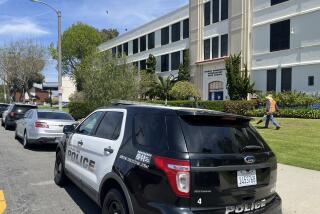Youth Drug Study Has Mixed Results : Survey: Cocaine and alcohol use by high school upperclassmen shows drop while younger students report rise in marijuana and inhalant use.
A recently released survey has given Pasadena Unified School District students mixed marks on drug use. The same study sent a somber message on their exposure to violence.
The survey of 2,800 Pasadena and Altadena students in grades four through 12 was the second of five annual studies by the USC Institute for Health Promotion and Disease Prevention Research.
The most recent results showed alcohol and cocaine to be on the decline with upperclassmen. Underclassmen and middle-school students, however, showed signs of increasing marijuana and inhalant use.
Regardless of grade level, the majority of students reported fear of violence. Many said they knew someone who had been shot or otherwise injured by gang violence, some fatally.
The survey, conducted last spring, found that slightly more than 36% of 11th- and 12th-graders reported alcohol use in the preceding 30 days, down from about 46% in 1992. The number of students in those grades who said they had consumed alcohol during the preceding week declined to 16.5% from 29.5% in 1992. Cocaine use among that group declined from 5.2% to 1.7% in 1993.
Marijuana, however, made a comeback among ninth- and 10th-graders, with 12.6% having used that substance in the preceding 30 days, up from 7% in 1992.
Among younger students, the survey contained both good and bad news. On the positive side, there was a 10% decline in the number of seventh- and eighth-graders who said they had tried alcohol--65.6%, compared with 75.2% in 1992. But 5% more students sniffed glue, paint, gasoline and other noxious substances than in 1992.
Cigarette-smoking declined among younger students. Of those in grades four through six, 5.9% said they had tried cigarettes, compared with 8.8% in 1992.
The annual survey is sponsored by Day One, a coalition of Pasadena and Altadena businesses, city agencies and nonprofit groups. The goal of the five-year study is to assess the effectiveness of drug programs for youths and determine ways to improve them.
Although she was “pleasantly surprised” at the sharp drop in alcohol use, Day One Executive Director Francisca Neumann did not find the increased use of some other substances surprising.
She attributed the disparity to more focused efforts against alcohol and cocaine. “But on marijuana and inhalants, you don’t see that message broadcast loud and clear as a no-no. They haven’t been targeted as strongly,” Neumann said.
The Day One survey results were released shortly after the publication of national figures on school-age drug use compiled by the University of Michigan for the National Institute on Drug Abuse. The national study showed that after years of steady decline, illicit drug use is making a comeback on some levels, particularly involving marijuana, LSD and amphetamines.
According to the national results, 28% of high school seniors admitted having had five or more drinks in one sitting during the two weeks preceding the survey. The local figure was half that, with 14.2% of Pasadena and Altadena upperclassmen reporting they had been drunk within the preceding 30 days.
While the respondents may have sent mixed messages on the use of illicit substances, the statistics formed one clear message: An increasing cloud of violence hangs over students’ lives.
In the local survey, 55% of ninth- and 10th-graders said they knew individuals injured or killed as a result of gang fights. Fifty-one percent feared being shot. Eleven percent carry a gun when they go out.
Nearly a third of 11th- and 12th-graders said they have had a firearm pointed at them. Two-thirds knew someone who had been shot and nearly half--48%--said they knew someone who had died or been injured in a gang fight.
Vera J. Vignes, Pasadena Unified School District superintendent, said the statistics on violence were among the survey’s most jarring.
The Day One survey, she said, “does not let us forget that we have to come together to ensure the safety of our children.”
More to Read
Sign up for Essential California
The most important California stories and recommendations in your inbox every morning.
You may occasionally receive promotional content from the Los Angeles Times.










